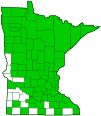spotted knapweed
(Centaurea stoebe ssp. micranthos)
Conservation • Weed • Description • Habitat • Ecology • Use • Distribution • Taxonomy
Description |
||
Spotted knapweed is a 12″ to 48″ tall, erect, biennial or short-lived perennial forb that rises on 1 to 20 stems from a stout taproot. In the first year it produces a rosette of basal leaves. In the second year it sends up 1 to 20 leafy flowering stems. The stems are erect or ascending, somewhat 4-angled but not winged, and branched at or above the middle. They are whitish- or grayish-green and rough to the touch due to a sparse covering of minute, short, stiff hairs. When young, they are also covered with short, soft, matted, woolly hairs, but these disappear quickly. Basal leaves are inversely lance-shaped to elliptic in outline, up to 6″ long, and up to 2¾″ wide. They whitish- or grayish-green and are usually deeply pinnately divided into 2 to 4 pairs of lobes. The outermost leaves of the rosette may be undivided or have a few teeth. Stem leaves are alternate. Lower stem leaves are stalkless or on short stalks and similar to basal leaves. Middle and upper stem leaves are mostly stalkless. The leaf blade either does not or only slightly extends down the stem. Middle stem leaves are deeply pinnately divided into several pairs of linear lobes, the lobes often again divided. The leaves become much smaller and less divided as they ascend the stem. Uppermost leaves are mostly unlobed, especially within the inflorescence. The upper surface and lower surfaces are rough to the touch due to a sparse covering of minute, short, stiff hairs. The margins are untoothed. The inflorescence is a single ¾″ to 1″ in diameter flower head at the end of the stem and each branch. At the base of the flower head is an egg-shaped, ⅜″ to ½″ long, ¼″ to 5 ⁄16″ in diameter whorl of bracts (involucre). The bracts of the involucre are pressed closely together. They do not have sharp spines at the tip. They are green with dark brown to black tips and have a fringe of stiff, spreading or upward curved bristles. The bristles eventually turn black and have the appearance of eyelashes. The “eyelashes” are short, no more than half as long as the bract to which they are attached is wide. There are numerous disk florets and no ray florets. The outermost disk florets are enlarged, sterile, and light purple to pinkish-purple. They may appear ray-like but closer examination shows them to be short tubes with 5 long lobes. The inner florets are white to pink and fertile. The fruit is a dry, brown or blackish-brown seed capsule (cypsela) with a single seed. It has a tuft of white, 1 ⁄32″ to ⅛″ long bristles at the tip. |
||
Height |
||
12″ to 48″ |
||
Flower Color |
||
Pink to purple |
||
Similar Species |
||
| Bachelor’s button (Centaurea cyanus) stem leaves are lance-shaped and unlobed. The leaf underside is woolly, even at maturity. It has blue to purple flowers. The tips of the involucral bracts are not dark, though the “eyelashes” are. | ||
Habitat |
||
Dry. Roadsides, railroads, abandoned fields, ditches, disturbed sites. Full sun. |
||
Ecology |
||
Flowering |
||
June to September |
||
Pests and Diseases |
||
|
||
Use |
||
|
||
Distribution |
||||
|
Sources |
|||
| 1/3/2023 | ||||
Nativity |
||||
Native to Europe. Introduced and widely naturalized in North America. |
||||
Occurrence |
||||
|
||||
Taxonomy |
|||
| Kingdom | Plantae (Plants) | ||
| Division | Tracheophyta (Vascular Plants) | ||
| Subdivision | Spermatophytina (Seed Plants) | ||
| Class | Magnoliopsida (Dicots) | ||
Order |
Asterales (Sunflowers, Bellflowers, Fanflowers, and Allies) | ||
Family |
Asteraceae (Sunflowers, Daisies, Asters, and Allies) | ||
| Subfamily | Carduoideae (thistles and allies) | ||
| Tribe | Cardueae | ||
| Subtribe | Centaureinae (knapweeds and allies) | ||
| Genus | Centaurea (knapweeds) | ||
| Subgenus | Centaurea | ||
| Section | Centaurea | ||
| Species | Centaurea stoebe (spotted knapweed) | ||
Subordinate Taxa |
|||
|
|||
Synonyms |
|||
Acosta maculosa Centaurea biebersteinii Centaurea maculosa |
|||
Common Names |
|||
spotted knapweed |
|||
Glossary
Bract
Modified leaf at the base of a flower stalk, flower cluster, or inflorescence.
Cypsela
A dry, one-chambered, single-seeded seed capsule, formed from a single carpel, with the seed attached to the membranous outer layer (wall) only by the seed stalk; the wall, formed from the wall of the inferior ovary and also from other tissues derived from the receptacle or hypanthium, does not split open at maturity, but relies on decay or predation to release the contents.
Involucre
A whorl of bracts beneath or surrounding a flower, flower head, or flower cluster.
Linear
Long, straight, and narrow, with more or less parallel sides, like a blade of grass.
Visitor Photos |
|||||
Share your photo of this plant. |
|||||
| This button not working for you? Simply email us at info@MinnesotaSeasons.com. Attach one or more photos and, if you like, a caption. |
|||||
Alfredo Colon |
|||||
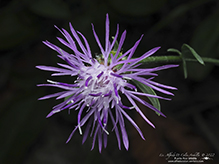 |
|||||
MinnesotaSeasons.com Photos |
|||||
Plant |
|||||
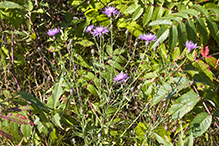 |
|||||
Inflorescence |
|||||
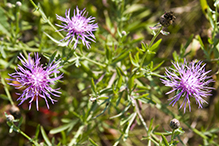 |
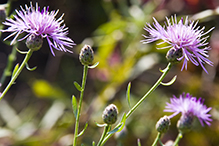 |
||||
Flower Head |
|||||
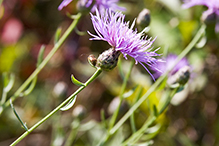 |
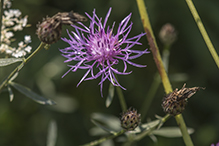 |
||||

Slideshows |
||
| Centaurea maculosa Matt Lavin |
||

|
||
About
Introduced perennial with stems upwards of 1 m tall, the fringed-tipped involucral bracts (phyllaries) often have a dark patch (hence the common name), corolla usually rose-purple, rarely white, dry disturbed sites or on well-drained substrates (e.g., river and stream gravel) from low elevations to mountain meadows and mountain big sagebrush steppe. |
||
| Spotted Knapweed (Centaurea maculosa) Andree Reno Sanborn |
||
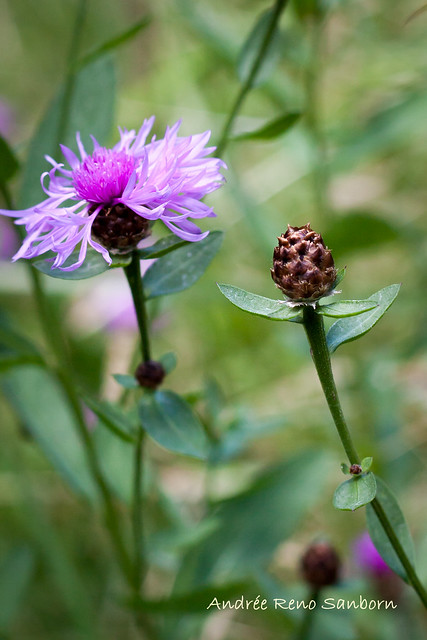
|
||
| Centaurea stoebe (Spotted Knapweed) Allen Chartier |
||

|
||

Visitor Videos |
|||
Share your video of this plant. |
|||
| This button not working for you? Simply email us at info@MinnesotaSeasons.com. Attach a video, a YouTube link, or a cloud storage link. |
|||
Other Videos |
|||
| Spotted Knapweed, identification of the Wisconsin Invasive Species Centaurea stoebe uwcoopextension |
|||
About
Uploaded on Jan 31, 2011 This is part of a series of videos providing key characteristics for the identification of invasive plants listed in Wisconsin's invasive species administrative rule NR 40. These videos are produced by Dr. Mark Renz of the University of Wisconsin-Madison. For more information on invasive plants and invasive plant management in Wisconsin visit http://fyi.uwex.edu/weedsci or http://ipcm.wisc.edu/Publications/WeedSciencepublications/tabid/116/Default.aspx |
|||
| LITTLE THINGS big problems-- Spotted Knapweed Gr8LakesRestoration |
|||
About
Uploaded on Oct 3, 2011 The Apostle Islands National Lakeshore is a collection of isolated islands in Lake Superior. Its natural beauty brings thousands of people to kayak, bird watch, sight see, camp, fish, and hike. With these recreationist also comes the potential to introduce non native plants and animals to new places. One plant of major concern is spotted knapweed. It is a beautiful purple flower, but prevents other plants from growing nearby. It is moved accidently from one island to another by seeds stuck to people and their gear. The National Park Service works hard to control its spread, but needs your help. Keep your gear clean, especially when moving from one trail to another or from island to island. |
|||
| Environmental Laboratory - U.S. Army Corps of Engineers Environmental Laboratory USACE |
|||
About
Published on Feb 15, 2013 Centaurea biebersteinii - Spotted Knapweed |
|||

Visitor Sightings |
|||||
Report a sighting of this plant. |
|||||
| This button not working for you? Simply email us at info@MinnesotaSeasons.com. Be sure to include a location. |
|||||
| Alfredo Colon 8/15/2022 |
Location: Albany, NY |
 |
|||
MinnesotaSeasons.com Sightings |
|||||

|
Created: Last Updated: © MinnesotaSeasons.com. All rights reserved. |
